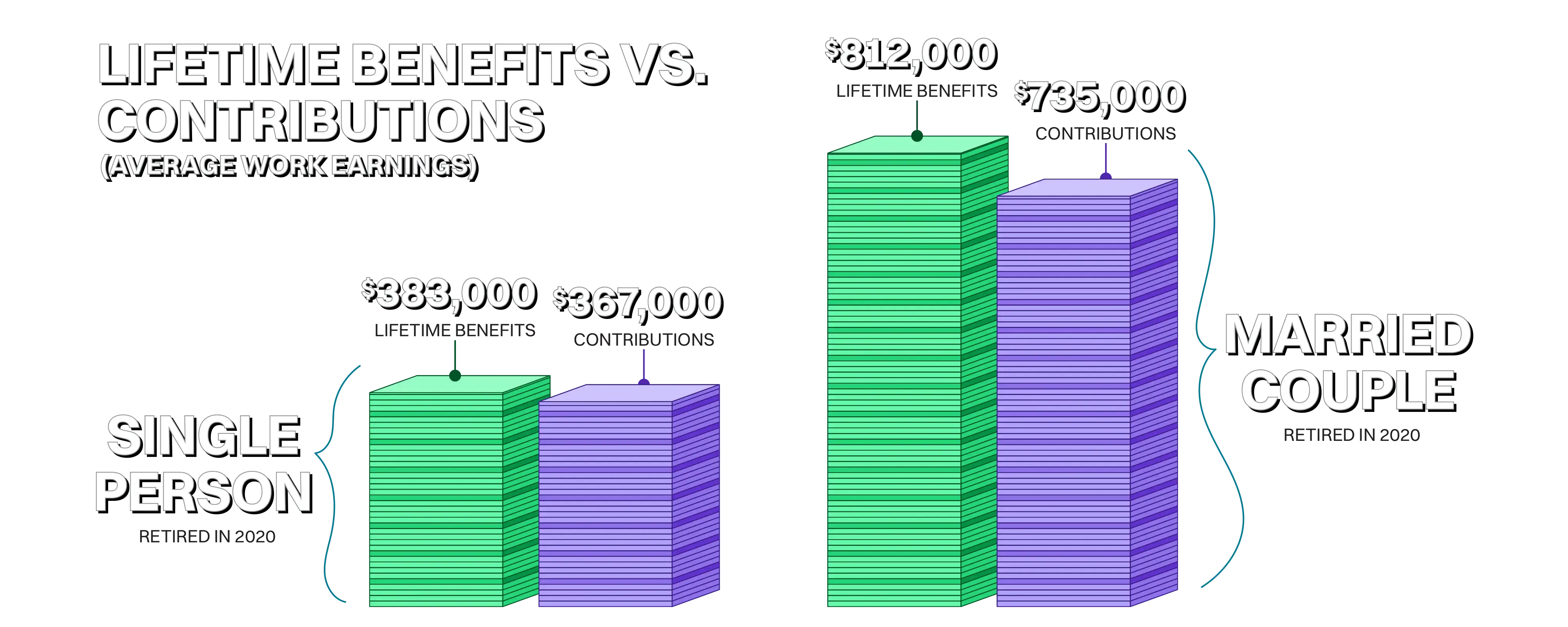How It Works
Think back to the first paycheck you ever received. Like many young Americans, you were probably surprised by the actual amount - and not because it was more money than you expected.
That’s because your paycheck isn’t the total amount of money you’ve earned in a pay period. It’s your earnings after you’ve paid taxes. One of those taxes is the payroll tax that funds Social Security.
THE Social Security PAYROLL TAX
The taxes that fund Social Security go by two different names, depending on the employment arrangement of the person paying them:
- If you are in a traditional employment situation where you work for an employer, the tax is called the FICA (for the Federal Insurance Contributions Act).
- If you are self-employed, the tax is called the SECA (for the Self-Employed Contributions Act).
But whether you pay the FICA tax or the SECA tax, the basics are the same:
For every dollar that you earn, 6.2% goes to the U.S. Treasury to fund the Old-Age, Survivors, and Disability Insurance program (OASDI, for short).
If you have a traditional employer, they send an additional 6.2% on your behalf.
If you are self-employed, you pay that extra 6.2% as well.
In total, 12.4% in payroll taxes are sent to the U.S. Treasury for every dollar you earn.

The U.S. Treasury puts this tax money into two trust funds that are managed by the Social Security Administration:
- A small percentage of your payroll taxes (1.8% of the 12.4%) go into the Disability Insurance (DI) Trust Fund, which covers disability benefits.
- Most of this payroll tax (10.6% of the 12.4%, to be exact) goes to the Old Age and Survivors Insurance (OASI) Trust Fund. This trust fund distributes benefits to eligible retirees.
THE TAXABLE MAXIMUM
Now, just when you thought you understood payroll taxes, things get a little more complicated. Welcome to what's known as the "taxable maximum."
So far, we've established the following:
- You and your employer pay a combined 12.4% payroll tax on every dollar that you earn. If you're self-employed, you pay the full 12.4% yourself.
- These payroll taxes fund the Old Age and Survivors Insurance (OASI) program and the Disability Insurance (DI) program, each of which have their own trust funds.
Here is where things get tricky:
You (and your employer, if you have one) only pay this tax up to what is known as the “taxable maximum.”
The taxable maximum is a limit set by Congress. It determines how much of a person’s annual earnings are subject to the Social Security payroll tax.
This year the taxable maximum is $168,600.
That means that, in 2024, you (and your employer, if you have one) will pay a total of 12.4% in payroll taxes on every dollar that you earn…. until your cumulative total earnings reach $168,600 for the year.
What happens if you earn $168,601 - or more - this year?
Any money that you earn above the taxable maximum isn’t subject to the payroll tax. Neither you (nor your employer) will pay the tax again until the next calendar year, when the running tally on your total annual earnings resets.
PROGRAM ELIGIBILITY
By paying these taxes, you are slowly qualifying to receive benefits from the Social Security program.
If you have: (1) paid the payroll tax for ten years or more, and (2) been a legal, permanent resident of the United States for five years or more by the time you reach the retirement age, then the Social Security Administration will begin sending you a benefit check every month.
CALCULATING BENEFITS
You might be wondering: how much money will you get from Social Security? Well… it depends.
In 2024, the average monthly Social Security benefit is $1,907, but yours could be higher or lower. It depends on a few factors.
The first factor is your earnings history. When you retire, the Social Security Administration tallies up what you made during your highest 35 years of earnings. And this is just one reason why it’s important to understand the taxable maximum. That limit doesn’t just impact the payroll taxes you pay as a worker; it also helps determine the benefits you receive as a retiree. That’s because only earnings below the taxable maximum are used to calculate the amount of your Social Security benefit.
The second factor is where your earnings place you on the income continuum. Were you a high earner who reached the taxable maximum every year? Were you a low-income earner who hovered close to the poverty line? Or were you somewhere in between?
The answer to those questions helps determine your benefit calculation. That’s because Social Security benefits are progressive. This means that, as a percentage of pre-retirement income, a low-income earner will receive a more generous monthly benefit than a high-income earner.
Importantly, once you start receiving benefits, you’ll see annual increases in your initial benefit to account for inflation. This is known as the cost-of-living adjustment, or COLA for short.
HOW MUCH WILL I GET?
What does all of this mean for you over your lifetime?
Well… if you’re a single person with average earnings, who retired in 2020, you would receive around $383,000 in lifetime benefits after paying $367,000 during your working years.
If you’re a married couple with average earnings, who retired in 2020, you would receive around $812,000 in benefits after paying $735,000 during your working years.
How much will you pay? And how much will you get out? Read more at the yellow sticky note to find out.











.svg)

